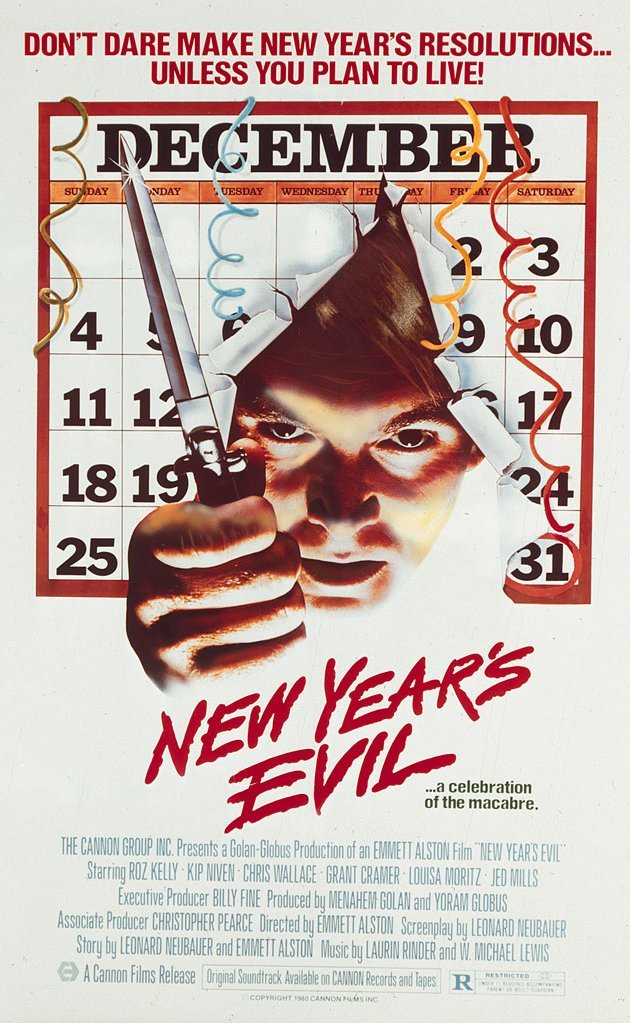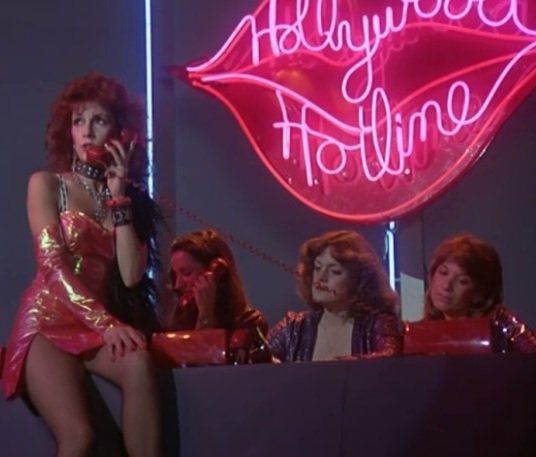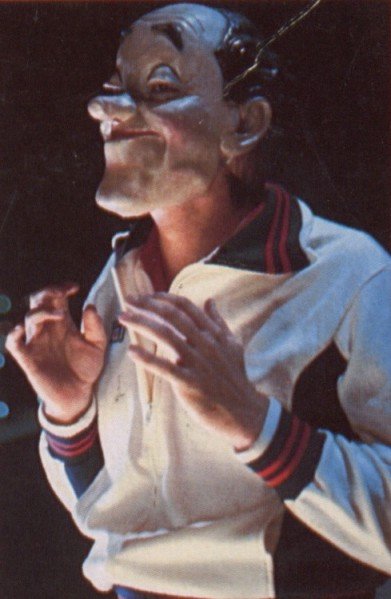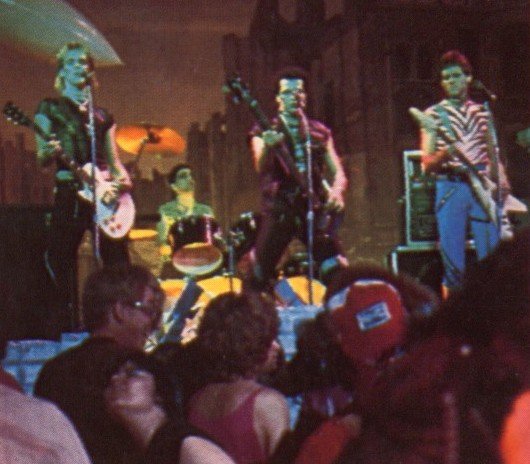NEW YEAR'S EVIL: I Don't Love L.A.
Once Halloween and Friday The 13th were back-to-back box office hits, enterprising producers fell in love with creating slasher variations for every conceivable holiday: My Bloody Valentine, Silent Night Deadly Night, April Fool's Day, etc. New Year's Eve was snatched up early by the producers of New Year's Evil in 1980. It's not as fondly remembered as its holiday-killer brethren often are but it has enough interesting quirks and clever ideas to make it worth a spin for the stalk-and-slash archaeologist. New Year's Evil revolves around the end-of-year edition of "Hollywood Hotline," a punkish variation on American Bandstand in which people call in to vote on their favorite "new wave" hits. The host is Blaze (Roz Kelly), an aging rocker queen who doesn't let a failing marriage or a dysfunctional, aspiring-actor son (Grant Cramer) get in the way of maintaining her fame.However, her show is about to get more sensationalistic than expected when someone calling himself Evil rings her up and announcing his plans to murder someone at the stroke of midnight for each time zone. Said killer (Kip Niven) is a resourceful fellow who races around Los Angeles to kill women for each target time. Meanwhile, Blaze keeps the show going while the cops hunt for the killer - but the killer has his eye on killing Blaze to commemorate New Year's for the West Coast.New Year's
New Year's Evil revolves around the end-of-year edition of "Hollywood Hotline," a punkish variation on American Bandstand in which people call in to vote on their favorite "new wave" hits. The host is Blaze (Roz Kelly), an aging rocker queen who doesn't let a failing marriage or a dysfunctional, aspiring-actor son (Grant Cramer) get in the way of maintaining her fame.However, her show is about to get more sensationalistic than expected when someone calling himself Evil rings her up and announcing his plans to murder someone at the stroke of midnight for each time zone. Said killer (Kip Niven) is a resourceful fellow who races around Los Angeles to kill women for each target time. Meanwhile, Blaze keeps the show going while the cops hunt for the killer - but the killer has his eye on killing Blaze to commemorate New Year's for the West Coast.New Year's Evil is usually ignored or quickly dismissed in roundups of beloved slasher films. Part of this might be because it emerged before the slasher film's rules were set in stone so it doesn't deliver a lot of things slash-addicts expect: the body count is low, the gore is negligible and there's more interest in cat-and-mouse suspense that flamboyantly-staged killing scenes. Given the Los Angeles setting and the killer's predilection for female victims, it often feels more like a psycho movie than a true slasher (you might get a Toolbox Murders vibe when he's stalking his prey).That said, New Year's Evil is both better and more interesting that it is often given credit for. The central "kill for each time zone" concept is inspired, as is revealing the killer's face upfront and making the suspense surrounding him be about why he's killing rather than his identity. The characters are more interesting than usual for a slasher, with Blaze being a final girl that is presented in an interestingly
Evil is usually ignored or quickly dismissed in roundups of beloved slasher films. Part of this might be because it emerged before the slasher film's rules were set in stone so it doesn't deliver a lot of things slash-addicts expect: the body count is low, the gore is negligible and there's more interest in cat-and-mouse suspense that flamboyantly-staged killing scenes. Given the Los Angeles setting and the killer's predilection for female victims, it often feels more like a psycho movie than a true slasher (you might get a Toolbox Murders vibe when he's stalking his prey).That said, New Year's Evil is both better and more interesting that it is often given credit for. The central "kill for each time zone" concept is inspired, as is revealing the killer's face upfront and making the suspense surrounding him be about why he's killing rather than his identity. The characters are more interesting than usual for a slasher, with Blaze being a final girl that is presented in an interestingly  ambivalent way: she often veers from sympathetic to hard-hearted in the same scene and Kelly captures this duality well. Niven is also scarier than the usual slasher because he can put on a convincing display of normality before breaking out his switchblade.Director Emmett Alston manages a few compelling setpieces along the way: the best might be a moment where the killer finds himself cornered in a drive-in after angering a group of bikers. It's also worth noting that the cinematography by future Hollywood d.p. Thomas Ackerman (working here as "Edward Thomas") is fantastic, doing impressive work in a lot of low-lighting night exteriors.Time has also given New Year's Evil a certain early '80s retro charm, what with its focus on "new wave" music and its followers. The t.v. show scenes have real, unknown L.A.-area bands performing original songs that are always amusing and sometimes quite catchy, like the unforgettable theme song. The scenes
ambivalent way: she often veers from sympathetic to hard-hearted in the same scene and Kelly captures this duality well. Niven is also scarier than the usual slasher because he can put on a convincing display of normality before breaking out his switchblade.Director Emmett Alston manages a few compelling setpieces along the way: the best might be a moment where the killer finds himself cornered in a drive-in after angering a group of bikers. It's also worth noting that the cinematography by future Hollywood d.p. Thomas Ackerman (working here as "Edward Thomas") is fantastic, doing impressive work in a lot of low-lighting night exteriors.Time has also given New Year's Evil a certain early '80s retro charm, what with its focus on "new wave" music and its followers. The t.v. show scenes have real, unknown L.A.-area bands performing original songs that are always amusing and sometimes quite catchy, like the unforgettable theme song. The scenes  depicting the audience are a hoot, showing a gang of Central Casting-style punks in a Halloween version of punk fashion and hairstyles (you haven't seen a group of faux-"punks" like this since the infamous Quincy episode "Next Stop, Nowhere").However, the unsung element of New Year's Evil is the way it acts as a sort of poison-pen valentine to show business and Los Angeles culture in general. The travails of Blaze's personal life show her to be someone who has achieved her minor-league fame at the expense of her most important personal relationships. The audience she vamps for is presented as a gang of braindead no-hopers (tellingly, they are intercut with mental patients as the film crosscuts between a murder at an asylum and the show). There's also a darkly humorous scene where the killer chats up a vapid victim by pretending to be an agent to the stars and is forced to endure a lot of vapid L.A. new-age chat.In short, New Year's Evil doesn't hit all the marks a slasher fan might expect but there's a lot more going here than the usual killing-with-sharp-objects thrills. As such, it's an interesting variant on the expected formula and a worthwhile curio for students of '80s horror.
depicting the audience are a hoot, showing a gang of Central Casting-style punks in a Halloween version of punk fashion and hairstyles (you haven't seen a group of faux-"punks" like this since the infamous Quincy episode "Next Stop, Nowhere").However, the unsung element of New Year's Evil is the way it acts as a sort of poison-pen valentine to show business and Los Angeles culture in general. The travails of Blaze's personal life show her to be someone who has achieved her minor-league fame at the expense of her most important personal relationships. The audience she vamps for is presented as a gang of braindead no-hopers (tellingly, they are intercut with mental patients as the film crosscuts between a murder at an asylum and the show). There's also a darkly humorous scene where the killer chats up a vapid victim by pretending to be an agent to the stars and is forced to endure a lot of vapid L.A. new-age chat.In short, New Year's Evil doesn't hit all the marks a slasher fan might expect but there's a lot more going here than the usual killing-with-sharp-objects thrills. As such, it's an interesting variant on the expected formula and a worthwhile curio for students of '80s horror.


